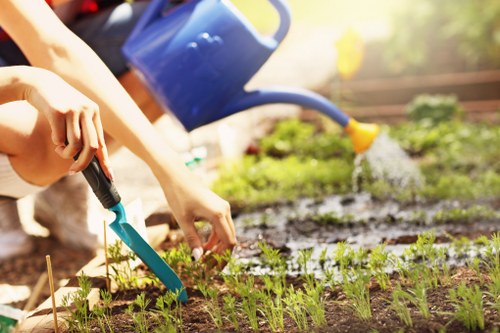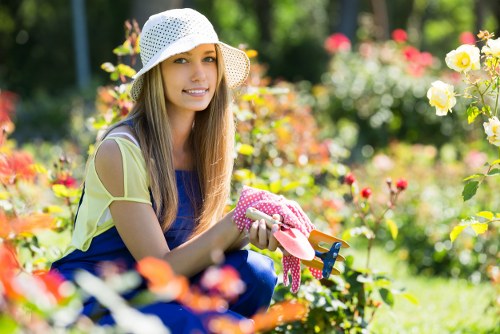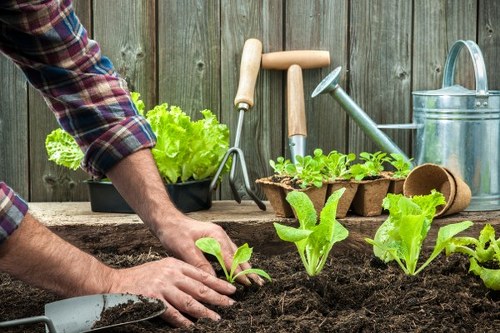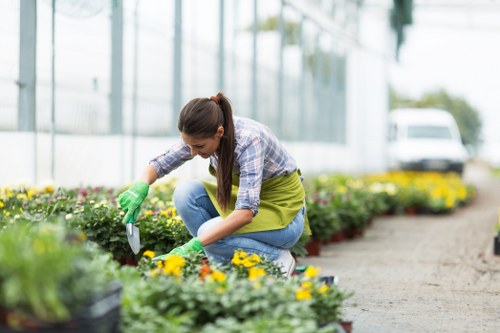Mastering Landscape Gardening: A Comprehensive Guide for Gardeners

Introduction to Landscape Gardening
Landscape gardening is more than just planting flowers and trees; it's an art that combines creativity, functionality, and sustainability to transform outdoor spaces into beautiful and harmonious environments. Whether you're a seasoned gardener or a beginner, understanding the principles of landscape gardening can help you design a space that not only looks stunning but also thrives in your local climate.
In this guide, we'll explore the essential aspects of landscape gardening, including planning, plant selection, soil preparation, and maintenance tips. By the end, you'll have the knowledge and inspiration to create a landscape that reflects your personal style and enhances your property's value.
Let's dive into the world of landscape gardening and discover how you can become a proficient landscape gardener.

Planning Your Landscape Garden
Assessing Your Space
Before you start digging and planting, it's crucial to assess the space you have. Consider factors such as:
- Size and shape of your garden area
- Sunlight exposure
- Soil type and drainage
- Climate and weather patterns
- Existing structures and features
Understanding these elements will help you make informed decisions about plant selection and garden layout.
Setting Goals and Budget
Determine what you want to achieve with your landscape garden. Are you looking to create a relaxing sanctuary, a space for entertaining, or a vibrant display of flowers and foliage? Setting clear goals will guide your design choices and ensure your garden meets your expectations.
Additionally, establish a budget to manage costs effectively. Landscaping can range from simple DIY projects to elaborate installations, so knowing your financial limits will help you prioritize and plan accordingly.

Designing Your Landscape
Creating a Layout
A well-thought-out layout is the foundation of successful landscape gardening. Start by sketching a rough plan of your garden, marking existing features and noting areas for new installations. Consider the flow of movement, focal points, and the balance between different elements.
Elements to Include
- Hardscaping: Pathways, patios, decks, and walls
- Softscaping: Plants, flowers, shrubs, and trees
- Water features: Ponds, fountains, and waterfalls
- Lighting: Outdoor lamps and garden lights
Incorporating a mix of these elements can add texture, depth, and interest to your garden.
Selecting Plants
Choosing the right plants is crucial for the success of your landscape garden. Consider the following factors:
- Climate compatibility: Select plants that thrive in your local climate
- Soil requirements
- Sunlight needs
- Maintenance levels
- Blooming seasons
Opt for a variety of plants that offer different colors, textures, and heights to create a dynamic and visually appealing garden.

Soil Preparation and Health
Testing and Amending Soil
Healthy soil is the backbone of any thriving garden. Start by testing your soil to determine its pH level and nutrient content. You can purchase a soil testing kit or send a sample to a local extension office for analysis.
Based on the results, amend your soil to create an optimal growing environment. Common amendments include:
- Adding organic matter such as compost or aged manure
- Incorporating perlite or sand to improve drainage
- Adjusting pH levels with lime or sulfur
Mulching for Moisture and Weed Control
Mulch plays a vital role in maintaining soil health. It helps retain moisture, suppress weeds, and regulate soil temperature. Apply a 2-3 inch layer of organic mulch around your plants, ensuring you leave space around stems and trunks to prevent rot.
Additionally, mulch breaks down over time, enriching the soil with nutrients and improving its structure.

Planting and Maintenance
Proper Planting Techniques
Planting correctly is essential for the longevity and health of your garden. Follow these steps for successful planting:
- Digging the right hole size: The hole should be twice as wide and the same depth as the plant's root ball
- Gently loosen the roots before placing the plant in the hole
- Fill the hole with a mixture of native soil and compost
- Water thoroughly after planting to settle the soil
Routine Watering and Fertilizing
Consistent watering is crucial, especially during the establishment phase. Most plants require deep, infrequent watering to encourage strong root growth. Adjust your watering schedule based on rainfall and seasonal changes.
Fertilize your plants regularly to provide essential nutrients. Use organic fertilizers to promote soil health and reduce the risk of chemical buildup.
Pest and Disease Management
Preventing and managing pests and diseases is a key aspect of landscape gardening. Implement integrated pest management (IPM) strategies, which include:
- Encouraging beneficial insects
- Using natural or organic pesticides
- Removing affected plant parts promptly
- Maintaining plant health through proper care
Regular monitoring and early intervention can keep your garden thriving and minimize damage.

Sustainable Landscape Practices
Water Conservation
Implementing water-saving techniques not only benefits the environment but also reduces your water bills. Consider the following practices:
- Drip irrigation systems: Deliver water directly to plant roots, minimizing evaporation
- Collecting rainwater for irrigation
- Using drought-resistant plants
- Mulching to retain soil moisture
Native Plant Selection
Choosing native plants is a sustainable landscaping approach that supports local ecosystems. Native plants are well-adapted to the climate, require less maintenance, and provide habitat for native wildlife.
Integrating native species into your garden can enhance biodiversity and create a resilient landscape.
Composting and Soil Health
Composting organic waste enriches your soil with valuable nutrients and improves its structure. Set up a compost bin to recycle kitchen scraps, garden trimmings, and other biodegradable materials.
Regularly adding compost to your garden beds enhances soil fertility and promotes healthy plant growth.

Seasonal Gardening Tips
Spring Preparation
Spring is the perfect time to prepare your garden for the growing season. Start by clearing out any winter debris and reviving your soil with compost.
- Plant early-blooming flowers and perennials
- Prune shrubs and trees to encourage new growth
- Plan and order seeds for summer planting
Summer Care
During the summer months, focus on maintaining hydration and managing growth. Implement the following strategies:
- Water deeply and consistently
- Mulch to conserve moisture and regulate soil temperature
- Monitor plants for signs of stress and pest activity
- Prune as needed to maintain shape and health
Autumn Maintenance
Autumn is ideal for preparing your garden for the winter. Actions to take include:
- Planting bulbs for spring blooms
- Raking fallen leaves and composting them
- Protecting sensitive plants from frost
- Cleaning and storing garden tools
Winter Planning
Use the winter months to plan for the next growing season. Research new plants, design layout changes, and order seeds or plants in advance.
Indoor gardening activities, such as starting seedlings, can give your garden a head start when spring arrives.

Enhancing Your Garden with Features
Water Features
Water features like ponds, fountains, and waterfalls add a tranquil element to your landscape garden. They not only enhance the aesthetic appeal but also attract wildlife and create a soothing ambiance.
- Choose a location that complements your garden layout
- Ensure proper maintenance to prevent algae and pests
- Incorporate lighting for evening ambiance
Outdoor Lighting
Strategic lighting can highlight key features, improve safety, and extend the usability of your garden into the evening. Consider the following types of lighting:
- Path lights: Illuminate walkways
- Spotlights for focal points
- Ambient lighting for seating areas
Energy-Efficient Options
Opt for energy-efficient lighting solutions such as LED lights or solar-powered fixtures to reduce energy consumption and lower your carbon footprint.
Garden Structures
Adding structures like pergolas, arbors, and garden benches can provide functionality and aesthetic value. These elements offer support for climbing plants, create shaded areas, and serve as focal points within your garden.
- Choose materials that complement your garden style
- Ensure structures are durable and weather-resistant
- Incorporate comfortable seating for relaxation
Pathways and Hardscaping
Pathways guide movement through your garden and connect different areas. Materials such as stone, gravel, or wood can be used to create visually appealing and functional paths.
Integrating hardscaping elements like patios and decks expands your outdoor living space, providing areas for dining, lounging, and entertaining.

Choosing the Right Plants
Perennials vs. Annuals
Understanding the difference between perennials and annuals is key to selecting the right plants for your garden:
- Perennials: Live for multiple years, providing long-term structure and continuous blooms
- Annuals: Complete their life cycle in one season, offering vibrant and varied colors
A mix of both can create a dynamic and ever-changing garden landscape.
Flowering Plants
Flowering plants add color and fragrance to your garden. Popular choices include:
- Roses for their classic beauty and variety
- Lavender for its soothing scent and attractiveness to pollinators
- Marigolds for bright, cheerful blooms
- Sunflowers for their bold presence
Foliage Plants
Foliage plants contribute texture and greenery, enhancing the overall visual appeal. Consider plants like:
- Hostas for their diverse leaf shapes and colors
- Ferns for a lush, tropical feel
- Boxwood for structured, evergreen borders
- Japanese maples for their striking foliage
Trees and Shrubs
Incorporating trees and shrubs adds height and structure to your garden. Select species that fit your climate and garden size, such as:
- Oak trees for their grandeur and longevity
- Magnolias for their stunning blossoms
- Hydrangeas for their abundant flowers
- Azaleas for vibrant spring blooms

Maintaining Your Landscape Garden
Regular Pruning and Trimming
Pruning maintains the shape and health of your plants. Remove dead or diseased branches, and trim overgrown areas to encourage new growth and improve air circulation.
Weed Control
Weeds compete with your plants for nutrients and water. Implementing regular weeding sessions and using mulch can effectively manage weed growth.
Lawn Care
If your landscape includes a lawn, proper maintenance is essential. This includes mowing, aerating, and overseeding to keep the grass healthy and vibrant.
Eco-Friendly Practices
Adopt eco-friendly lawn care practices such as using organic fertilizers, reducing chemical pesticides, and conserving water through efficient irrigation techniques.
Seasonal Clean-Up
Each season brings different maintenance tasks. In the fall, clear fallen leaves and prepare plants for winter. In the spring, refresh garden beds and address any winter damage.
Consistent maintenance ensures your landscape garden remains beautiful and resilient throughout the year.

Innovative Landscape Gardening Ideas
Vertical Gardening
Maximize space and add visual interest with vertical gardening. Use trellises, wall-mounted planters, or vertical structures to grow climbing plants and create living walls.
Native Wildlife Habitats
Design your garden to support local wildlife by incorporating features such as birdhouses, bee hotels, and native plant species. This promotes biodiversity and creates a vibrant ecosystem.
Edible Landscaping
Combine beauty and functionality by integrating edible plants into your landscapegarden. Grow vegetables, herbs, and fruit trees alongside ornamental plants for a productive and attractive garden.
Minimalist Gardens
Embrace simplicity with minimalist garden designs. Focus on clean lines, uncluttered spaces, and a limited color palette to create a serene and modern outdoor environment.
Water-Efficient Gardens
Design gardens with water efficiency in mind. Use xeriscaping techniques, drought-tolerant plants, and efficient irrigation systems to reduce water usage without compromising beauty.

Tools and Equipment for Landscape Gardening
Essential Tools
Having the right tools makes landscape gardening more efficient and enjoyable. Essential tools include:
- Shovel and spade for digging and planting
- Pruners and shears for trimming and shaping
- Rake for leveling soil and removing debris
- Garden hose and watering cans for irrigation
- Wheelbarrow for transporting materials
Power Tools and Equipment
For larger projects, consider investing in power tools such as:
- Lawnmowers for maintaining grassy areas
- String trimmers for edging and trimming
- Chainsaws for cutting larger branches and trees
- Rototillers for preparing garden beds
Safety Gear
Protect yourself while gardening by wearing appropriate safety gear. Items to consider include:
- Gloves to protect your hands
- Safety goggles to shield your eyes
- Sturdy footwear for support and protection
- Hats and sunscreen for sun protection
Storage Solutions
Keep your tools organized and in good condition with proper storage solutions. Options include:
- Garden sheds for large equipment
- Toolboxes and racks for smaller tools
- Storage benches that double as seating
Maintaining your tools ensures longevity and reliable performance in your landscape gardening endeavors.

Inspiring Landscape Gardening Projects
Creating a Butterfly Garden
A butterfly garden attracts these beautiful pollinators with nectar-rich flowers and host plants for caterpillars. Choose plants like milkweed, butterfly bush, and lantana to create a vibrant and lively habitat.
Designing a Zen Garden
Zen gardens emphasize simplicity, tranquility, and natural beauty. Incorporate elements such as sand, rocks, gravel, and carefully placed plants to create a meditative and serene space.
Building a Herb Garden
An herb garden is both practical and aromatic. Plant a variety of culinary and medicinal herbs like basil, rosemary, thyme, and mint. Use raised beds or container gardens for easy maintenance.
Installing a Fire Pit Area
A fire pit provides a focal point for social gatherings and outdoor relaxation. Surround the fire pit with comfortable seating, such as benches or Adirondack chairs, and incorporate lighting for ambiance.
Creating a Rock Garden
Rock gardens showcase a variety of rocks and alpine plants. Select drought-tolerant species like sedum, sempervivum, and ornamental grasses to thrive in the rocky environment.

Common Landscape Gardening Mistakes to Avoid
Ignoring Site Conditions
Failing to consider the specific conditions of your site, such as soil type, sunlight, and drainage, can lead to poor plant performance. Always assess and prepare your site adequately before planting.
Overcrowding Plants
Planting too closely can result in competition for resources, leading to stunted growth and increased susceptibility to pests and diseases. Follow recommended spacing guidelines for each plant.
Neglecting Maintenance
Regular maintenance is essential for a healthy and attractive garden. Skipping tasks like watering, pruning, and weeding can quickly lead to a neglected appearance.
Choosing the Wrong Plants
Selecting plants that are not suited to your climate or site conditions can result in poor growth and high maintenance. Research and choose plants that thrive in your specific environment.
Forgetting About Scale and Proportion
Ensuring that plants and garden elements are in proportion to each other and the overall space is crucial for a balanced and harmonious design. Avoid extreme sizes that can overwhelm or underwhelm your garden.

Advanced Landscape Gardening Techniques
Pruning for Shape and Health
Advanced pruning techniques, such as crown thinning and canopy raising, can improve plant health and enhance their natural shape. Learn the specific methods for each type of plant to avoid damage.
Soil Amendment Strategies
Beyond basic soil preparation, consider advanced soil amendment techniques like cover cropping, green manures, and biochar addition to improve soil fertility and structure.
Propagation Methods
Propagating plants through seeds, cuttings, grafting, or layering allows you to expand your garden and preserve desirable plant traits. Mastering these techniques can save costs and increase plant diversity.
Advanced Irrigation Systems
Invest in smart irrigation systems that use weather data and soil moisture sensors to optimize water usage. Automated systems can save time and ensure your plants receive the right amount of water.
Mulching Techniques
Experiment with different mulching materials and methods to enhance soil health and moisture retention. Consider using recycled materials, colored mulches for visual interest, or living mulches like cover crops.

Choosing the Right Landscape Gardener
Qualifications and Experience
When hiring a landscape gardener, consider their qualifications and experience. Look for certifications, a strong portfolio, and positive references to ensure they have the expertise to bring your vision to life.
Communication and Collaboration
Effective communication is key to a successful gardening project. Choose a gardener who listens to your ideas, offers professional advice, and collaborates with you throughout the process.
Cost and Contracts
Discuss costs upfront and ensure you understand the terms of any contracts. A reputable landscape gardener will provide clear estimates and detailed agreements to prevent misunderstandings.
Aftercare Services
Inquire about aftercare services such as maintenance plans, seasonal check-ins, and support for any issues that may arise. Ongoing support ensures your garden remains healthy and beautiful over time.
Sustainability Practices
Select a landscape gardener who prioritizes sustainable practices. This includes using eco-friendly materials, promoting native plant species, and implementing water-efficient solutions.

Conclusion
Landscape gardening is a rewarding endeavor that combines creativity, knowledge, and dedication. By understanding the fundamentals and embracing sustainable practices, you can create a stunning and resilient garden that enhances your outdoor living space.
Whether you're designing a small urban garden or a sprawling backyard, the principles outlined in this guide will help you achieve a beautiful and functional landscape. Remember to plan thoughtfully, choose the right plants, maintain your garden regularly, and seek professional help when needed.
Start your landscape gardening journey today and transform your garden into a masterpiece that you can enjoy for years to come.
Contact us today to begin designing your dream landscape garden!



